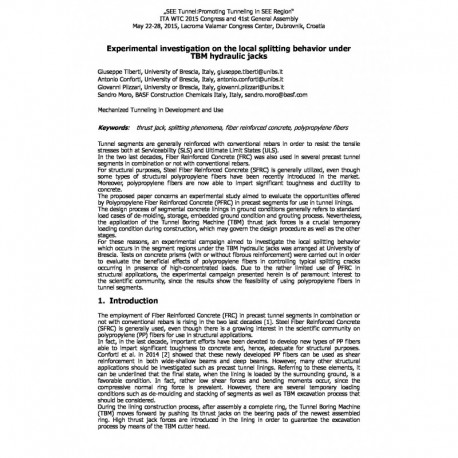Cart
0
0
No document
0,00 €
Total
Document successfully added to your shopping cart
Quantity
Total
There are 0 items in your cart.
There is 1 item in your cart.
Total documents
Total shipping
To be determined
Total
Search & filter
Search for a publication
Search & filter
Experimental investigation on the local splitting behavior under TBM hydraulic jacks
wtc2015_full_tiberti
G. Tiberti / A. Conforti / G. Plizzari / S. Moro
The employment of Fiber Reinforced Concrete (FRC) in precast tunnel segments in combination or not with conventional rebars is rising in the two last decades [1]. Steel Fiber Reinforced Concrete (SFRC) is generally used, even though there is a growing interest in the scientific community on polypropylene (PP) fibers for use in structural applications. In fact, in the last decade, important efforts have been devoted to develop new types of PP fibers able to impart significant toughness to concrete and, hence, adequate for structural purposes. Conforti et al. in 2014 [2] showed that these newly developed PP fibers can be used as shear reinforcement in both wide-shallow beams and deep beams. However, many other structural applications should be investigated such as precast tunnel linings. Referring to these elements, it can be underlined that the final state, when the lining is loaded by the surrounding ground, is a favorable condition. In fact, rather low shear forces and bending moments occur, since the compressive normal ring force is prevalent. However, there are several temporary loading conditions such as de-moulding and stacking of segments as well as TBM excavation process that should be considered. During the lining construction process, after assembly a complete ring, the Tunnel Boring Machine (TBM) moves forward by pushing its thrust jacks on the bearing pads of the newest assembled ring. High thrust jack forces are introduced in the lining in order to guarantee the excavation process by means of the TBM cutter head.




